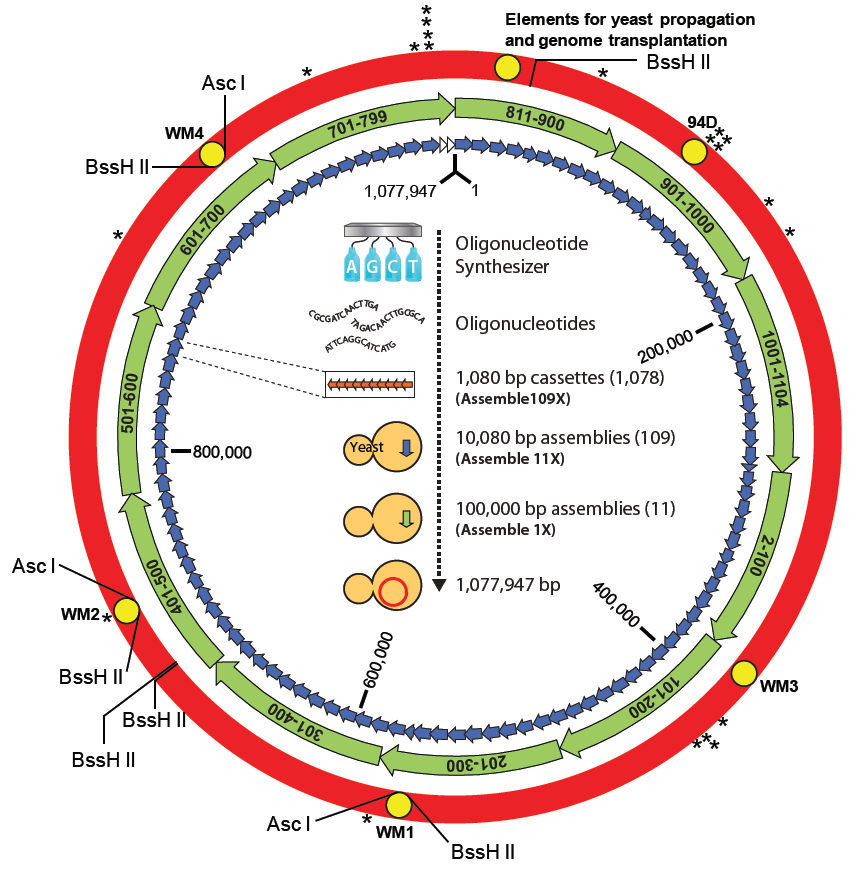First self-replicating, synthetic bacterial cell
May 20, 2010
Researchers at the J. Craig Venter Institute (JCVI), a not-for-profit genomic research organization, published results today describing the successful construction of the first self-replicating, synthetic bacterial cell.
The team synthesized the 1.08 million base pair chromosome of a modified Mycoplasma mycoides genome. The synthetic cell is called Mycoplasma mycoides JCVI-syn1.0 and is the proof of principle that genomes can be designed in the computer, chemically made in the laboratory and transplanted into a recipient cell to produce a new self-replicating cell controlled only by the synthetic genome.
“Its genome was designed in the computer and brought to life through chemical synthesis, without using any pieces of natural DNA,” said JCVI Distinguished Investigator Clyde Hutchison.
The JCVI scientists envision that the knowledge gained by constructing this first self-replicating synthetic cell, coupled with decreasing costs for DNA synthesis, will give rise to wider use of this powerful technology. This will undoubtedly lead to the development of many important applications and products including biofuels, vaccines, pharmaceuticals, clean water and food products.
“This will essentially enable us to design new life forms at a computer screen,” said Ray Kurzweil. “This will be a fabulous creative tool for creating inexpensive clean fuels and other breakthroughs for agriculture, health, and the environment. It’s also enabling for a bioterrorist, so we urgently need a rapid response system (like we do have for software viruses) that can protect us from new biological viruses and other life forms. The technologies to do this are in place — we can now sequence a biological virus in about a day, a bacterium in a few days (HIV took five years), and we have a range of tools to deactivate these pathogens (such as RNA interference or antigen based vaccines). I’ve advised the Army on how to set up such a system and I know that it is underway, but we need to substantially increase its priority.”
The team designed and inserted “watermarks” into the genome –specifically designed segments of DNA that use the “alphabet” of genes and proteins that enable the researcher to spell out words and phrases. Encoded in the watermarks is a new DNA code for writing words, sentences and numbers. In addition, there is a web address to send emails to if you can successfully decode the new code, the names of 46 authors and other key contributors and three quotations: “TO LIVE, TO ERR, TO FALL, TO TRIUMPH, TO RECREATE LIFE OUT OF LIFE.” – JAMES JOYCE; “SEE THINGS NOT AS THEY ARE, BUT AS THEY MIGHT BE.”-A quote from the book, “American Prometheus”; “WHAT I CANNOT BUILD, I CANNOT UNDERSTAND.” – RICHARD FEYNMAN.
More info: J. Craig Venter Institute news

The assembly of a synthetic M. mycoides genome in yeast (Figure from Gibson, D. G., J. I. Glass, et al. 2010. Creation of a bacterial cell controlled by a chemically synthesized genome. Science, Published online May 20 2010)